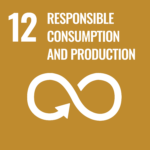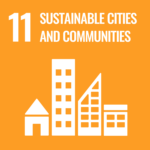New Streets from Old Tires in Cameroon
Design of a hydrocarbon binder using plastic waste and old tires
This project is carried out as part of a doctoral thesis carried out by the student group leader and therefore builds up on preliminary research.
It aims to recycle non-biodegradable waste (non-opaque, transparent and colored plastic bottle waste, tire waste) to allow its reuse or application in the production of a less expensive and more resistant material for the construction of new tarred roads in Cameroon. For this purpose, a hydrocarbon binder is designed. In doing so, the project also aims to conserve resources, particularly non-renewable aggregates (gravel and sand), which will be in reduced quantities in the new asphalt road construction.
The sub-objectives of this research projects are:
- Reduce plastic waste and provide an alternative method of recycling plastic which is usually just incinerated in Cameroon
- Preserve the non-renewable resources needed for road construction in Cameroon
- Reduce the cost of constructing tarred roads in Cameroon
Quarterly project updates
The student team mobilized all the material needed for the research, carried out preliminary fundamental tests on different bituminous concrete specimens formulated with plastic waste. In this quarter, two main experiments were carried out to test the mixture of the bituminous concrete specimens formulated with plastic waste and to further characterize it. All experiments were carried out in cooperation with an accredited laboratory in Cameroon.
Execution of the Duriez tests
The objective of this test is to measure the water resistance of the bituminous concrete specimens formulated with plastic waste. This resistance is important because it ensures that the experimental mixture can be used in road construction in a satisfactory way as well in dry as rainy weather. The activity consists of two main stages. In the first step, the test pieces are prepared. For this, cylinders of the experimental mixture are made. In the next step, measurements of the compressive strengths of the mixture are carried out. Some of the test pieces are immersed in water while their measurements are carried out. These are compared with the results of the dry test pieces. The resistance to water is characterized by the ratio of resistances with or without immersion. The simple compressive strength at a given temperature, with or without immersion, is the ratio of the maximum load to the circular section of the specimens. It is the average of four or five measurements depending on the size of the hydrocarbon mixture being tested.
Execution of the Marshall tests
The objective of this test is to ensure the conformity of the production of the bituminous concrete specimens formulated with plastic waste in the sense that the experimental mixture produced in the production site must be transported to the site where it will be used or tested. It is thus necessary to ensure (due to the long distances to be covered) that the characteristics of the experimental mixture at the exit of the production site is not too much affected by the transport. This is verified by the creep stability. For the Marshall test as well, cylindrical test pieces of the experimental mixture are made for the realization of the stability and deformation test. The deformation test analyzes the deformation of concrete when it is subjected to mechanical stresses of long duration. The purpose of the Marshall test is therefore to determine, for a given compaction, the stability and the deformation of a specimen of determined dimensions. It is applicable to all hot experimental mixtures not containing aggregates larger than 20 mm.
Taking into consideration the margin of errors, the Duriez and Marshall tests were carried out on a total of 4 experimental mixtures which on average yielded positive results.
In the second quarter, the students continued their experiments on the experimental mixtures of bituminous concrete specimens formulated with plastic waste to further characterize the hydrocarbon mixture.
Execution of the PCG - Presse à Compactage Giratoire test (gyratory compaction press)
The PCG test is a test characterizing the evolution of the percentage of voids in a hydrocarbon mixture subjected to isothermal compaction. This compaction is obtained by the combination of a gyratory shear and an axial resultant force applied by a mechanical head. This test is applied to the hydrocarbon experimental mixtures, either made in the laboratory. The objective of this test is therefore to assess the suitability for compaction of experimental mixtures. This experiment is important because it ensures that the mixture will keep the acceptable characteristics during and after the compaction operation. The cylindrical test pieces of the experimental mixture are made for the execution of this experiment. The measurement of the void indices according to the number of gyrations were then carried out.
For each number of gyrations, the percentage of voids and the compactness are determined. The values to be compared to the normative interval are those obtained at 100 gyrations. In this case as well, the results of the 4 experimental mixtures comply with the specifications, taking into account the margins of error.
Due to unavailability of necessary equipment for the execution of the experiment in Cameroon, the PCG test was carried out in Chad through the SICAL Laboratory.
In this quarter, the students were able to carry out the most important and complex test of all. The rutting tests, whose objective is to determine the resistance of the experimental mixtures of bituminous concrete specimens formulated with plastic waste to specific deformations. This characteristic is important because it translates the durability of the mixture according to the cycles of constraints. They would also be able to obtain the final report summarizing all the tests with the conclusion of the laboratory on the quality of their experimental mixtures of bituminous concrete specimens formulated with plastic waste.
Execution of the Rutting Tests
The objective of this test is to analyze the susceptibility of the experimental mixtures to deformation by measuring the depth of rutting caused by the repeated passage of a rolling load at a fixed temperature. This test applies to mixtures with the largest granular dimensions less than or equal to 32 mm. The bituminous concrete specimens formulated with plastic waste are placed in a mold with their surface in contact with the top of the mold.
The deformation behavior of bituminous materials is evaluated by the depth of the rut that forms following repeated passages of a rolling load at constant temperature. Three types of devices can be used in accordance with this standard: large devices, extra large devices and small devices. With large and extra large devices, the specimens are air-conditioned during the test. With small devices, they are conditioned either in air or in water. Under each wheel of the device, the percentage of ruts is evaluated at different cycles (1,000, 3,000, 10,000, and 30,000) and must be within the normative range.
The measurements of void indices according to the number of gyrations for the prepared test pieces are carried out and the results are evaluated.
Like the PCG tests, the rutting test was carried out in Chad through the SICAL laboratory and not in Cameroon, due to the unavailability of equipment. This was possible because of the relationship of trust between the student group and the laboratory. The samples were transported by road to Chad.
Photo Gallery
Figure 1: Crushing of a Duriez test specimen
Figure 2: Crushing of a Marshall test piece
Figure 3: PCG apparatus (left) and test sample (right)
Figure 4: Rutting apparatus (rutting machine)






Facts
- Country: Cameroon
- Region Yaundé
- Project abbreviation: CMR-002
- Project start / project end: March 2022 - March 2023
- Project budget: 7,845,000.00 FCFA
(appr. 12,000.00 €, currency exchange rate as of 09 Mar 2022) - Scholarship per person: 135,000.00 FCFA per quarter
(appr. 205.00 €, currency exchange rate as of 09 Mar 2022) - University: Université de Yaoundé I
- Local partner: FOOTPRINT
- Number of students: 5 (2 female)
- Supervisor: Dr. Doedonne Kunwufine
- Mentor: n/a
- 3E4A-Coordinator: Nathalie Tsafak
SDGs
Primary SDGs
Secondary SDGs
Partners
FOOTPRINT
Team
Isidore
Mbenkoue Mbida
Léopoldine
Tchitchui Djawa
Olivier Parfait
Abada
Christ
Mbia Ayi
Ramatou
Damandi
Supervisor
Dr. Deodonne
Kunwufine
Scientific Report
View Scientific report here





